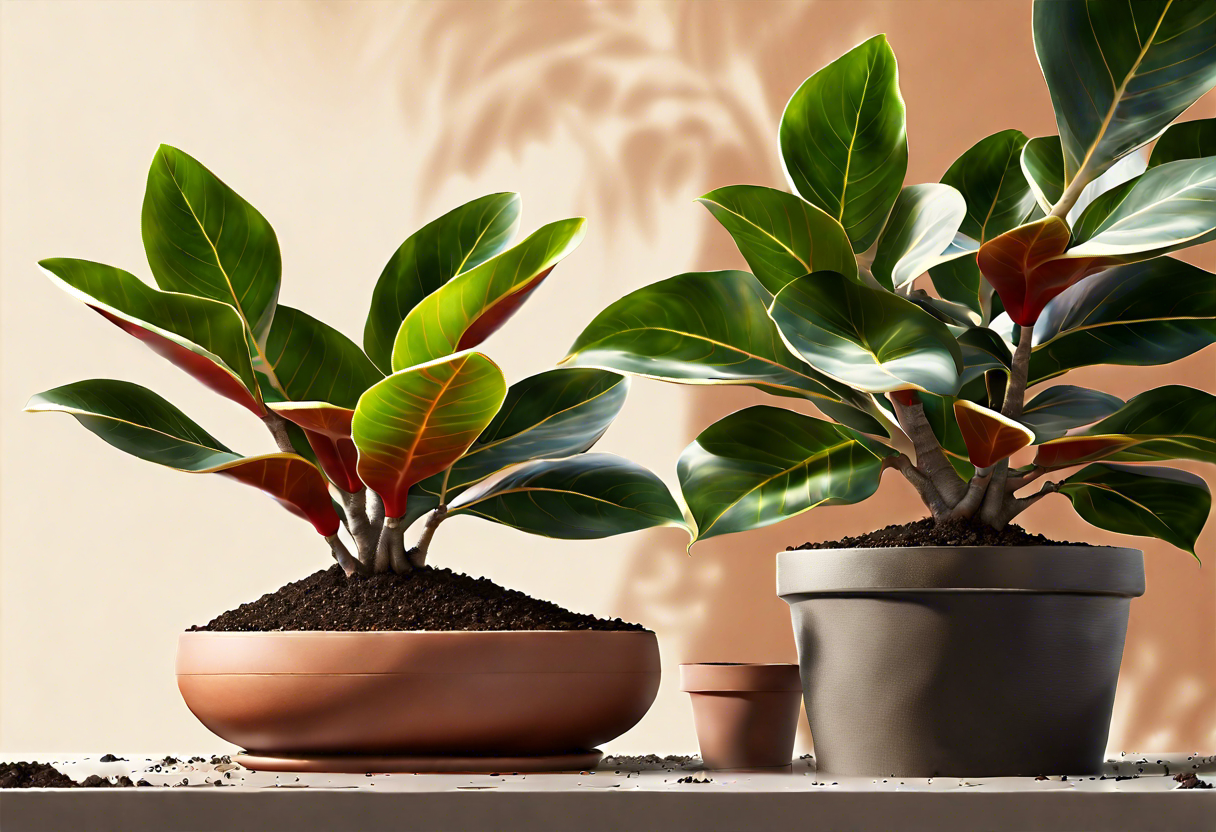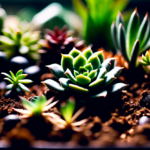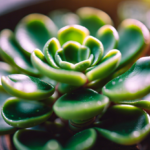Benefits of Using a Well-Draining Soil Mix for Rubber Plants
When it comes to the care and maintenance of your rubber plants, selecting the right soil or potting mix is crucial for their overall health and growth. A well-draining soil mix is particularly advantageous for these tropical and subtropical plants, such as the Rubber Plant (Ficus elastica), as it provides numerous benefits that contribute to their thriving success.
One of the primary advantages of using a well-draining soil mix is that it helps prevent waterlogged conditions, which can be detrimental to the roots of your rubber plant. An excessively moist environment may lead to root rot, causing the plant to wilt and eventually die. With a soil mix that drains well, excess water can easily escape, minimizing the risk of water accumulation and promoting a healthier root system.
Furthermore, a well-draining soil mix ensures that oxygen reaches the roots of your rubber plant. Adequate oxygenation is essential for the proper functioning of the roots and the overall growth of the plant. When the soil doesn’t drain well, oxygen cannot penetrate the root zone, depriving the plant of this vital element. By using a soil mix that provides good drainage, you ensure that your rubber plant receives the oxygen it needs to thrive.
In addition to preventing waterlogging and promoting oxygenation, a well-draining soil mix offers improved nutrient availability for your rubber plant. When water drains out of the soil, it carries with it any excess salts and harmful substances that may have accumulated. This prevents the build-up of toxic substances in the soil and reduces the risk of nutrient imbalances. As a result, the roots can efficiently absorb the essential nutrients they require for healthy growth.
The use of a well-draining soil mix also makes it easier to regulate the moisture levels for your rubber plant. These plants prefer moist soil, but not excessively wet conditions. A soil mix that drains well allows you to control the watering more accurately and helps avoid overwatering, which can potentially drown the roots. This way, you can strike a balance between providing adequate moisture and preventing the roots from sitting in water for extended periods.
Incorporating a well-draining soil mix when potting your Rubber Plant (Ficus elastica) offers several advantages that contribute to the overall health and vitality of the plant. It helps prevent waterlogged conditions, promotes oxygenation to the roots, improves nutrient availability, and enables better moisture regulation. By selecting the best soil or potting mix for your rubber plant, you can provide it with an optimal growing environment, ensuring its long-term success.
Factors to Consider When Choosing the Best Soil or Potting Mix for Rubber Plants
When it comes to caring for your rubber plants (Ficus elastica), choosing the right soil or potting mix is crucial for their overall health and growth. The soil plays a vital role in providing a suitable environment for the roots to absorb nutrients, moisture, and oxygen. Here are some important factors to consider when selecting the best soil or potting mix for your rubber plants.
-
Drainage: Rubber plants thrive in well-draining soil that allows excess water to flow out easily. Poor drainage can lead to waterlogged soil, which can cause root rot and other diseases. Look for a soil mix that contains perlite or sand to improve drainage and prevent water from pooling around the roots.
-
Moisture Retention: While good drainage is essential, it’s also important for the soil to retain some moisture to keep the plant hydrated. A balance between drainage and moisture retention is crucial. Opt for a soil mix that contains ingredients like peat moss or coconut coir, as they have excellent water-holding properties while still allowing excess water to escape.
-
Nutrient Content: Rubber plants require a nutrient-rich soil mix to support their growth. Look for a potting mix that contains organic matter, such as compost or well-rotted manure, as it provides essential nutrients for the plant. Additionally, consider using a slow-release fertilizer or incorporating a balanced fertilizer into the soil mix to ensure your rubber plant receives a continuous supply of nutrients.
-
pH Level: Rubber plants prefer slightly acidic to neutral soil with a pH range between 6.0 and 7.0. It’s crucial to choose a soil mix with the appropriate pH level to ensure optimal nutrient availability. You can test the pH level of the soil using a pH meter or a testing kit and make adjustments if necessary by incorporating materials like peat moss or lime.
-
Soil Aeration: Adequate air circulation around the roots is vital for the health of rubber plants. Choose a soil mix that is loose and well-aerated, allowing the roots to breathe and preventing the buildup of excess moisture. Adding perlite or vermiculite to the soil mix can help improve aeration.
When preparing the soil or potting mix for your rubber plant, it’s important to avoid common mistakes that can hinder its growth. These include using heavy, compacted soils that retain too much water, using soil mixes with a high proportion of sand, which can lead to rapid drainage and dry out the plant, or using old or contaminated soil that may harbor pests or diseases.
Selecting the best soil or potting mix for your rubber plants involves considering factors such as drainage, moisture retention, nutrient content, pH level, and soil aeration. By providing your rubber plants with a suitable soil environment, you can ensure their healthy growth and longevity. Remember to periodically check and adjust the soil conditions as needed to maintain optimal plant health.
Creating a Balanced and Nutrient-Rich Soil Mix for Optimal Rubber Plant Growth
When it comes to caring for your rubber plant (Ficus elastica), one of the most critical factors to consider is the soil or potting mix in which it is planted. Choosing the right soil mix is essential to provide your rubber plant with the necessary nutrients, aeration, and moisture retention for optimal growth. Here are some tips for creating a balanced and nutrient-rich soil mix for your rubber plant:
1. Well-Draining Soil: Rubber plants thrive in soil that provides excellent drainage. This prevents waterlogged soil, which can lead to root rot and other diseases. To ensure proper drainage, incorporate materials such as perlite, coarse sand, or vermiculite into your soil mix. These additives improve aeration and help excess water to flow out of the potting mix.
2. Organic Matter: Including organic matter in your soil mix is beneficial for rubber plant growth. Organic matter such as compost or well-rotted manure adds essential nutrients and improves the soil structure. It enhances water retention while still allowing excess water to drain away effectively. Aim to include approximately 25% to 30% of organic matter in your soil mix.
3. Nutrient-Rich Components: Rubber plants require a balanced mix of nutrients for healthy growth. Incorporate nutrient-rich components such as peat moss, coconut coir, or well-aged compost into your soil mix. These components provide essential elements like nitrogen, phosphorus, and potassium, which are vital for the plant’s development.
4. pH Level: Rubber plants prefer slightly acidic to neutral soil with a pH range of 6.0 to 7.0. Test the pH level of your soil mix before planting your rubber plant. If necessary, adjust the pH by adding amendments like lime to raise it or sulfur to lower it.
5. Avoid Heavy Soils: Rubber plants do not do well in heavy, compacted soils, as these can hinder root development and prevent proper moisture and nutrient uptake. Avoid using clay-based soils or any heavy soil mix that retains too much moisture. Instead, opt for well-draining soil mixes that provide a balance between moisture retention and aeration.
6. Commercial Potting Mixes: If you prefer a hassle-free option, consider using a commercial potting mix specifically formulated for houseplants. These mixes are often well-balanced and contain a combination of organic materials, fertilizers, and amendments that cater to the plant’s needs. Choose a high-quality potting mix suitable for indoor plants or tropical plants.
Creating a balanced and nutrient-rich soil mix is crucial for the optimal growth of your rubber plant. By incorporating well-draining soil, organic matter, nutrient-rich components, and maintaining the appropriate pH level, you can provide the ideal environment for your rubber plant to thrive. Avoid heavy soils and consider using commercial potting mixes for added convenience. With the right soil mix, your rubber plant will flourish, displaying its vibrant foliage and contributing to a beautiful indoor space.
The Importance of Soil Aeration and Moisture Retention for Rubber Plants
Rubber plants (Ficus elastica) are popular indoor plants known for their large, glossy leaves and ability to thrive in a variety of conditions. One key factor that can greatly influence the success of rubber plant growth is the choice of soil or potting mix. While there are various factors to consider when selecting the best soil mix, two crucial aspects to pay attention to are soil aeration and moisture retention.
Proper soil aeration is essential for rubber plants as it ensures that the roots receive adequate oxygen. Oxygen is vital for the root respiration process, which allows the plant to take up nutrients and perform various metabolic activities. Inadequate oxygen supply to the roots can lead to root rot and overall poor plant health. To promote soil aeration, it is crucial to use a well-draining soil mix that allows excess water to flow through easily. A loose and well-aerated soil mix will prevent waterlogging and help maintain a healthy root system.
Moisture retention is equally important for the optimal growth of rubber plants. While it is crucial to avoid waterlogging, the soil should also retain sufficient moisture to keep the plant hydrated. Rubber plants prefer a slightly moist but not overly saturated soil environment. A well-draining soil mix that retains moisture can help strike the right balance. organic matter such as peat moss or compost in the soil mix can improve moisture retention while still allowing excess water to drain away.
To create a balanced and nutrient-rich soil mix for rubber plants, incorporating organic matter such as compost or well-rotted manure is highly beneficial. Organic matter improves soil structure, promotes nutrient availability, and enhances moisture retention. It also acts as a source of slow-release nutrients that will sustain the plant’s growth over time. Mixing organic matter with a well-draining potting mix creates an ideal substrate that provides the necessary nutrients and moisture for the rubber plant to thrive.
When selecting or mixing soil for rubber plants, it is important to avoid common mistakes. Using heavy, compacted soils that do not drain well can lead to root rot and other moisture-related problems. Similarly, soils that are too sandy or lacking in organic matter may not retain enough moisture for the plant’s needs. Striking a balance between moisture retention and aeration is key to creating an optimal soil mix for rubber plants.
The choice of soil or potting mix greatly influences the growth and well-being of rubber plants. Ensuring proper soil aeration and moisture retention is crucial for their success. By using a well-draining soil mix that retains moisture while allowing excess water to drain away, rubber plants can truly thrive. organic matter further enhances the nutrient content and overall quality of the soil mix. The right soil mix will provide the necessary support, aeration, and moisture for the roots, resulting in healthy and vibrant rubber plants.
Common Mistakes to Avoid When Selecting or Mixing Soil for Rubber Plants
When it comes to growing healthy rubber plants (Ficus elastica), selecting the right soil or potting mix is crucial. The soil composition directly affects the plant’s overall growth, health, and longevity. However, there are several common mistakes that many people make when choosing or mixing soil for their rubber plants. To ensure optimal plant growth and avoid these pitfalls, it’s essential to be aware of these mistakes and take the necessary precautions.
One common mistake is using regular garden soil for rubber plants. While garden soil may be suitable for outdoor plants, it is not ideal for potted rubber plants. Garden soil tends to be heavy, compacted, and may not drain well in containers. This can lead to root rot, waterlogged soil, and ultimately, plant decline. Instead, opt for a well-draining potting mix specifically formulated for indoor plants.
Another mistake to avoid is using soil with inadequate aeration. Rubber plant roots require oxygen to thrive and grow. Heavy, compacted soil can impede airflow and suffocate the roots. To provide optimal aeration, consider adding perlite or vermiculite to the potting mix. These additives help loosen the soil, improve drainage, and promote healthy root development.
Overwatering is a common issue among rubber plant owners, often due to misconceptions about the plant’s water requirements. One mistake is selecting a soil mix that retains too much moisture. Rubber plants prefer slightly moist soil, but excessive water can lead to root rot and other fungal diseases. To prevent overwatering, it’s crucial to choose a well-draining soil mix that allows excess water to flow out of the container.
Additionally, an improper soil pH can affect the overall health of rubber plants. These plants thrive in slightly acidic to neutral soil conditions. Using soil with high or low pH levels can hinder nutrient absorption and impede root function. Before potting your rubber plant, test the pH of the soil mix and adjust if necessary using amendments such as peat moss or compost.
One should avoid using soil mixes that lack essential nutrients for rubber plants. While rubber plants are generally adaptable and can tolerate various soil conditions, using nutrient-poor soil can lead to stunted growth and nutrient deficiencies. Ensure that the potting mix contains organic matter, such as compost or well-rotted manure, to provide necessary nutrients for the plants.
Selecting the best soil or potting mix for rubber plants is paramount for their overall health and growth. Avoiding common mistakes such as using regular garden soil, inadequate aeration, overwatering, improper soil pH, and nutrient deficiencies will help ensure thriving rubber plants. By providing well-draining soil that promotes proper airflow, moisture retention, and optimal nutrient levels, you can create an ideal environment for your rubber plants to flourish for years to come.
Conclusion
Choosing the best soil or potting mix for your rubber plant is crucial for its overall health and growth. A well-draining soil mix provides numerous benefits, such as preventing root rot and allowing for sufficient oxygen flow to the roots. When choosing the right soil, consider factors such as the plant’s natural habitat, drainage capabilities, and nutrient requirements.
Creating a balanced and nutrient-rich soil mix is essential for promoting optimal rubber plant growth. By combining a mixture of organic matter, such as compost or peat moss, with a well-draining material like perlite or sand, you can create a soil mix that retains moisture while allowing excess water to drain away. Adding a slow-release fertilizer can also help provide essential nutrients to the plant over time.
Soil aeration and moisture retention are two critical factors for rubber plant health. Adequate aeration ensures that the roots receive enough oxygen, preventing suffocation and root rot. Meanwhile, proper moisture retention allows the plant to receive an adequate water supply without becoming waterlogged. Hence, it is crucial to strike a balance between these two factors when preparing your soil mix.
While creating the ideal soil mix for your rubber plant is essential, it’s equally important to avoid common mistakes. One such error is using a soil mix that retains too much moisture, leading to waterlogged roots and root rot. To avoid this, incorporate materials like perlite, sand, or vermiculite into your soil mix to improve drainage.
Using poor-quality or contaminated soil is another common mistake to avoid. It’s crucial to source high-quality potting soil or mix your own using fresh ingredients. Avoid using soil from your garden, as it may contain pests, diseases, or unwanted weed seeds that could harm your rubber plant.
Furthermore, neglecting to provide adequate nutrition can hinder the growth and overall health of your rubber plant. Consider supplementing your soil mix with a slow-release fertilizer or periodically applying a balanced liquid fertilizer to provide the necessary nutrients for optimal growth.
Selecting the best soil or potting mix for your rubber plant is essential for its well-being. By considering factors such as drainage, nutrition, aeration, and moisture retention, you can create a soil mix that promotes healthy growth. Avoid common mistakes like using poor-quality soil or neglecting to provide sufficient nutrition. With the right soil mix and proper care, your rubber plant will thrive and bring beauty to your indoor space for years to come.


